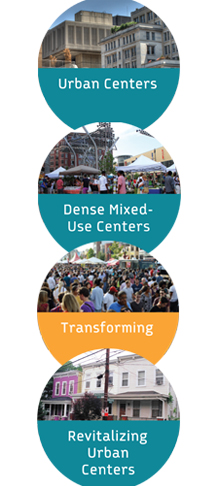“The Purple Line is going to be built” pronounced Montgomery County Executive Isiah Leggett to a room of over 250 locally elected civic and community leaders gathered at a workshop at the University of Maryland on March 21 to discuss community development challenges and opportunities along the region’s first rail line that will travel exclusively between Activity Centers outside of the District of Columbia. The Purple Line illustrates how our region has evolved from a “mono-centric” region with the vast majority of offices retail and civic institutions located in the District of Columbia to a “poly-centric” region where Activity Centers are found throughout the metropolitan region. The growth of these places has been fueled by key regional infrastructure investments including I-495 I-270 the Dulles Toll Road and the Metro system.
Construction of the Purple Line marks a new era in our region’s economy. Now households who use transit will be able to access many Activity Centers. The Purple Line will connect three of Maryland’s strongest Activity Centers -Bethesda Silver Spring and New Carrollton- with frequent reliable high capacity transit service for the first time. These connections will enable more people to find better jobs spend more time with family thanks to shorter commutes and access important services.
Recent and ongoing work at the Council of Governments is helping support planning efforts along the Purple Line Corridor. COG’s Place Opportunity report recommended strategies for its Activity Centers based on four key segments—Bethesda Silver Spring Takoma-Langley Park and New Carrollton. In addition a current study by the Transportation Planning Board is identifying key pedestrian and bicycle improvements near 25 transit stations including New Carrollton and Silver Spring to improve access to nearby employment sites and to make it easier for transit-dependent people to get around.

COG staff also participated in last Friday’s workshop organized by the Purple Line Corridor Coalition which brought regional leaders together to discuss lessons learned from new light rail investments in Denver and Minneapolis and to develop action priorities. The workshop priorities focused on four areas: supporting housing for all along the purple line building a thriving labor market supporting local business and building community through design and development.
At the end of the day the group identified five key tasks for the Purple Line Corridor Coalition.
1) Form partnerships between the state county governments and local community development organizations.
2) Identify an individual who is dedicated to finding opportunities and challenges along the Purple Line Corridor.
3) Identify the best community-building practices and policies for new light rail lines.
4) Begin preserving market rate affordable multifamily housing immediately.
5) Relocate support services for individuals and business impacted by the Purple Line to the corridor.
The Purple Line Corridor Coalition is a group of government civic and institutional stakeholders led by the University of Maryland National Center for Smart Growth. It was formed to address two key community development challenges likely to accompany the line—a dramatic increase in property values and removing barriers that impede the corridor from reaching its full potential.
As the transit project progresses COG will continue working with its partners in Maryland to ensure the new rail line meets its full potential and shapes more prosperous accessible livable and sustainable communities along the Purple Line.
To learn more about these Activity Centers and the opportunity and place types described below download our report Place Opportunity here.
 Bethesda Activity Center: Bethesda is a major regional job center with strong walkability and urban amenities. A key strategy for this segment is expanding housing options to provide low-to-moderate income households better access to the area’s jobs and amenities.
Bethesda Activity Center: Bethesda is a major regional job center with strong walkability and urban amenities. A key strategy for this segment is expanding housing options to provide low-to-moderate income households better access to the area’s jobs and amenities.
Silver Spring Activity Center: Silver Spring is a Dense Mixed-Use Center that has experienced recent revitalization. Given the area’s income diversity preserving existing affordable housing and expanding housing choice through a mix of market-rate and affordable housing would be key strategies in this part of the corridor. Due to strong momentum this segment of the corridor could benefit from partnerships such as a Business Improvement District or Community improvement District which manage and improve the public realm market the neighborhood and promote economic development.
Takoma–Langley Park Activity Center: This segment of the corridor includes Takoma/Langley Crossroads a revitalizing urban neighborhood that has a large concentration of low-income and immigrant households potentially vulnerable to displacement. Prioritizing existing affordable housing (particularly rental housing) and local and small businesses are critical for this Center. Many existing residents are transit-dependent and improving access to transit and existing amenities through walkability improvements are also a priority.
New Carrollton Activity Center: New Carrollton a Revitalizing Urban Center already has strong transit connections with Metro and MARC but could benefit from place-based strategies that incentivize market-rate development add community amenities and create a stronger public realm.